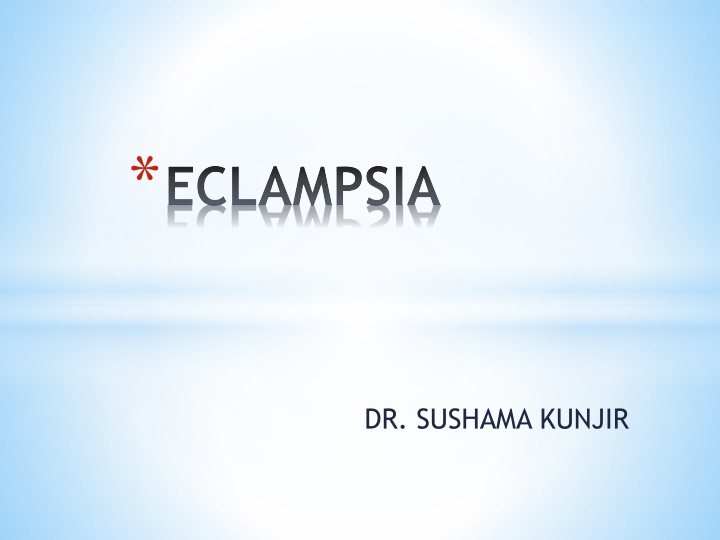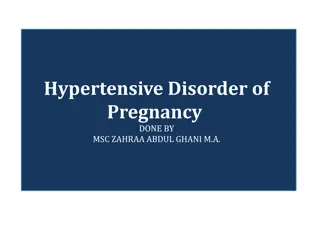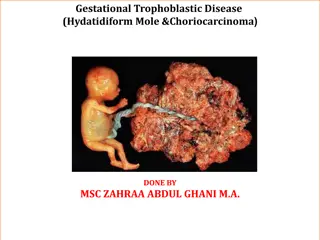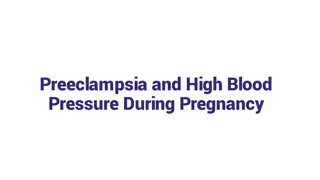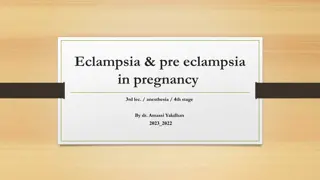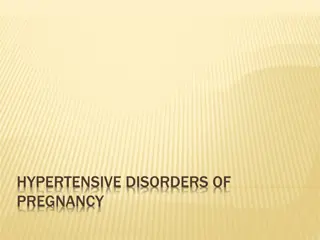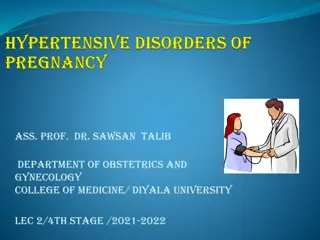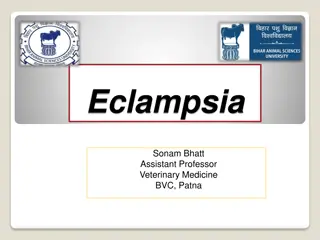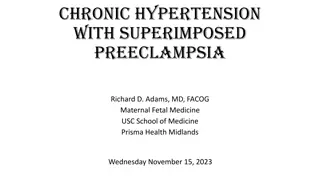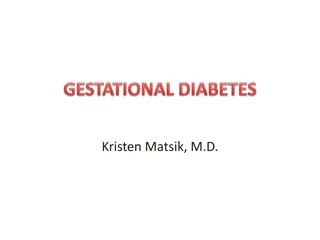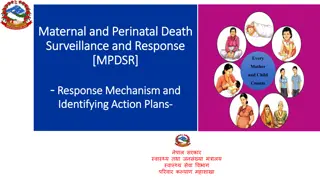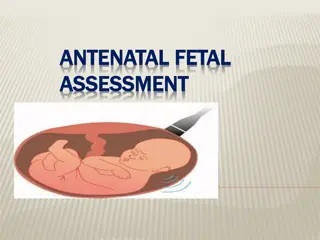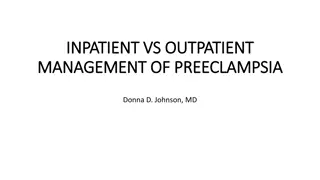Eclampsia and Preeclampsia
Eclampsia is a serious condition during pregnancy characterized by seizures due to high blood pressure. Preeclampsia, a related disorder, involves high blood pressure and protein in the urine. Risk factors include maternal age, obesity, and previous history of preeclampsia. Prompt treatment is essential to prevent complications for both the mother and baby.
Download Presentation

Please find below an Image/Link to download the presentation.
The content on the website is provided AS IS for your information and personal use only. It may not be sold, licensed, or shared on other websites without obtaining consent from the author.If you encounter any issues during the download, it is possible that the publisher has removed the file from their server.
You are allowed to download the files provided on this website for personal or commercial use, subject to the condition that they are used lawfully. All files are the property of their respective owners.
The content on the website is provided AS IS for your information and personal use only. It may not be sold, licensed, or shared on other websites without obtaining consent from the author.
E N D
Presentation Transcript
*ECLAMPSIA DR. SUSHAMA KUNJIR
*CASE *21 years Primigravida, with H/o 8 MA *Booked outside and first visit here *LMP- not known *Was brought to casualty with generalized tonic clonic convulsions
History obtained from mother in law. Obstetric H/O- Has only 3 antenatal visits of which one visit in I trimester, 2 visits in II trimester I Trimester uneventful II trimester No h/o headache, blurring of vision, convulsions III Trimester-H/o Pedal edema +,H/o convulsions+ at home, No H/o blurring of vision, epigastric pain, vomiting
*TREATMENT Turn the patient on her side with head lower Mouth gag, oral suctioning Nasal O2 IV LINE Stop convulsions inj MgSO4 Control BP-IV Labetalol Investigations I/O chart/catheterize Obstetric Rx-Fetal monitoring and urgent delivery
*DEFINITION International society for study of HTN in pregnancy defines: *Generalised tonic clonic convulsions *Associated with signs/symptoms of preeclampsia *Occurring during pregnancy, labor or within 7days of delivery *Not caused by epilepsy or other convulsive disorders
*ANTENATAL-50% *INTRAPARTUM-25% *POSTPARTUM-25%
*PREECLAMPSIA The presence of hypertension of at least 140/90 mm Hg recorded on two separate occasions at least 6 hours apart and in the presence of at least 300 mg protein in a 24 hours collection of urine arrising de novo after the 20thweek gestation in a previously normotensive women and resolving completetly by the sixth postpartum week.
*RISK FACTORS Primigravida Maternal age > 35 yrs African race Family History Diabetes Obesity Renal disease Previous history of PET Thrombophilias Multifetal pregnancy Molar pregnancy
*ETIOPATHOGENESIS (Abnormal immunological response/Genetic) (Deficient trophoplast invasion) (Hypoperfused placenta) (Circulating factors) (Vascular endothelial cell activation) (Clinical manifestations of the disease)
Symptoms of preeclampsia * May be symptomless * Headache * Visual symptoms * Epigastric and right abdominal pain * Less urine output Signs of preeclampsia * Hypertension * Non dependent edema * Brisk reflexes * Fundal height/IUGR
*LAB TESTS Multisystem Disorder Hemogram/Platelet Ct. S.LDH Renal function tests Liver function test S.UA Coagulation Profile Fundoscopy 24hr urinary Proteins/dipstick test
Fetus NST USG Doppler
*TREATMENT Ultimate Treatment DELIVERY of FETUS & PLACENTA
* MAGNESIUM SULPHATE FORMULATIONS Magnesium sulphate comes in varying concentration 50 % solution: 1gm in 2ml 25 % solution: 1gm in 4ml 20 % solution: 1gm in 5ml
*MECHANISM OF ACTION It acts as a vasodilator which prevents cerebral ischemia occurring in cases of severe pre eclampsia due to vasoconstriction thereby having a neuro- protective role Inhibitory action at the neuro muscular junction controls seizure activity Reduce release of glutamate Blocks glutamate receptor Blockage of calcium Enhances action of adenosine
*REGIMEN 1.PRITCHARD REGIMEN Loading dose: 4gm IV dose loading (20%) over 3m diluted in distilled water (to make 20ml) 10 gm IM dose in both the buttocks (5 gm in each buttock) Maintenance dose: 5gm magnesium sulphate every 4 hours on alternate buttocks
2. SARDESAI REGIMEN * Loading dose: 4gm IV/IM dose loading (20%) over 3m diluted in distilled water (to make 20ml) *Maintenance dose: 2gm given as IV/IM every 3hrs
3.ZUSPAN REGIMEN Loading dose: 4gm intravenous (20%) over 5-10 min Maintenance dose: 1-2 gm/ hour by controlled infusion pump for 24 hours
4. SIBAI REGIMEN Loading dose: 6gm of 20% magnesium sulphate solution in 100 ml of normal saline administered as intravenous infusion over 15-20 minutes Maintenance dose: continuous infusion of 50% magnesium sulphate solution dissolved in 1000 ml of normal saline administered at a drip rate of 100 ml/hour to ensure rate of 2gm of magnesium sulphate/ hour
IF SEIZURES PERSIST Seizures may reccur in 10-15% of the patients When such an event occurs 2gm intravenous dose of 20% solution is administered
*REGIMEN DURATION OF THERAPY Magnesium sulphate therapy is continued for 24 hours After delivery After last seizure Whichever occurs later
INTRAVENOUS INTRAMUSCULAR Better administration Erratic absorption and unpredictable action Increased risk of toxicity Safer Requires extensive monitoring with continuous ECG and pulse oximetry Painful and risk of gluteal abscess
*MONITORING 1. Urine output: magnesium is excreted by renal pathway. Thus if urinary output is less than 30 ml/ hour magnesium sulphate levels rise in systemic vasculature leading to magnesium toxicity 2.Deep tendon reflexes depression of deep tendon reflexes is the first sign of hypermagnesemia 3. Respiratory rate: respiratory rate of at least 14/ minute 4. Serum magnesium levels
*BENEFITS OF MAGNESIUM SULPHATE Lower incidence of recurrence of seizure Improved maternal mortality Less perinatal mortality Neuroprotective effects on fetus
*ADVERSE EFFECTS Therapeutic values 4-7 mEq/ L : therapeutic Toxicity 10 mEq/L: Loss of deep tendon reflexes >12 mEq/ L: respiratory depression > 15mEq/ L: cardiac arrest
NEONATAL DEPRESSION Magnesium sulphate crosses placenta. Neonatal hypermagnesemia can lead to loss of beat to beat variablity on electronic fetal monitoring Respiratory depression, flaccidity, and hyporeflexia have been reported in some neonates
*ANTIDOTE ANTIDOTE: CALCIUM GLUCONATE 10ml of 10% over 10 min IV
*CONTRAINDICATIONS Renal failure Myasthenia Gravis Myocardial ischaemia
ANTIHYPERTENSIVES (IV) LABETOLOL NTG HYDRALAZINE (if bp is 160 mm/Hg Systolic or 110 mmHg diastolic )
ANTIHYPERTENSIVES (Oral) LABETOLOL NIFEDEPINE (No sublingual) ALPHAMETHYL DOPA (if bp is 150 mm/Hg Systolic or 100 mmHg diastolic )
*PRES *The Posterior Reversible encephalopathy Syndrome (PRES) also called Posterior Leukoencephalopathy Syndrome is a clinico-neuro-radiologic entity. *Eclampsia is one of the important causes of PRES *Can be diagnosed only by MRI & is a reversible condition *Break down of brain vascular autoregulation due to high BP(posterior brain is less extensively innervated, so less able to adjust to blood pressure fluctuations) leading to vasogenic edema
* COMPLICATIONS OF ECLAMPSIA *PRES *ASPIRATION PNUEMONITIS *HEMIPLEGIA *BLINDNESS *PULMONARY EDEMA *PSYCHOSIS
